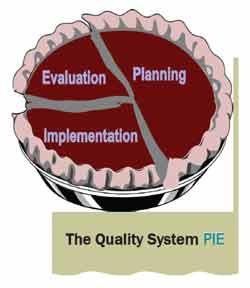About Managing the Quality of Environmental Data at EPA Region 3
Definitions
Environmental information or data is defined as any measurements or information that describe environmental processes, location, or conditions; ecological or health effects and consequences; or the performance of environmental technology. For EPA Region 3, environmental information also includes data compiled from other sources such as data bases or literature or produced from models.
If your project involves environmental data, as defined here, you need QA.

The Quality System PIE
P = Planning - Development of sampling network design, generation of appropriate data quality indicators, selection of measurement and analytical methodologies, standard operating procedures
I = Implementation - Just do what you planned!
E = Evaluation - Use of review, audit and assessment tools to determine whether environmental data operations comply with EPA Quality Assurance Policy
Quality Assurance Staff Expertise
- QA document preparation and review (e.g., Quality Management Plans, Quality Assurance Project Plans, Sampling Plans, etc.);
- Expert assistance on QA/QC policies, procedures, and requirements;
- Quality system and technical assessments of laboratory and field activities (e.g., audits);
- Assistance with environmental project planning;
- Review/advice on quality requirements for contracts, grants, and interagency agreements;
- Selection of laboratory and field analytical methods;
- Data validation and usability;
- Data interpretation and assessment; and
- Training in all of the above
